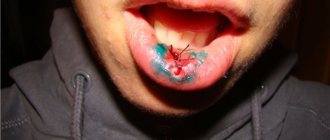Today it is difficult to surprise anyone with meat products, however, some offal products will help you find unusual combinations of delicate taste and rich nutrition. Unfortunately, not all housewives know how to properly cook beef tongue, and often deny themselves and their loved ones an original addition to the usual menu. However, such an oversight is easy to correct.
How to remove the skin from beef tongue
Advice to housewives who read our site on how to quickly and easily remove the skin from the tongue. We will talk specifically about boiled beef tongue, since, unlike pork, it has especially thick and tough skin, which causes difficulties in removing it.
To easily remove the skin from the tongue, you need to cook the tongue for a long time and patiently until it is completely cooked. The cooking time for beef tongue depends on its size and the age of the animal. On average, the process takes 2-3 hours in a regular saucepan or 40-50 minutes in a pressure cooker (for details, see the recipe “how to boil beef tongue”).
Some housewives remove the skin from the tongue almost at the beginning of cooking, 15 minutes after the water boils in the pan, but this is inconvenient, and the process is not so simple (I can’t even imagine how to remove the skin from a raw tongue).
We recommend that immediately after the tongue has cooked and you have turned off the stove, carefully remove it from the hot broth and place it under a generous stream of cold water. The surface of the tongue will quickly cool down and the skin will come off effortlessly.
Beneficial features
Beef tongue takes a long time to cook, in addition, it must be thoroughly cleaned - first to remove external contaminants and remaining films, and then remove the skin from it. Is this product worth the effort? Still, yes, it’s worth it.
- It has an unusually high zinc content. And iodine, phosphorus and calcium help the functioning of the endocrine system.
- Suitable for feeding people with diabetes.
- Helps accelerate tissue regeneration, which is necessary for people who have undergone surgery.
- Useful for patients with gastritis and peptic ulcers.
- In case of anemia, the tongue improves blood composition.
What to peel raw and what to peel cooked?
In order for the beef tongue to be tender and have a pleasant taste, you need to clean it properly. The procedure is carried out in two stages. A raw tongue must be cleaned of dirt, mucus or remaining blood.
Before this, the offal is soaked for at least half an hour, or better yet for an hour, in cold water. Anything that needs to be cleaned will become wet, making it much easier to remove waste from the surface of the tongue. After removing the meat from the water, soak it with a paper towel.
Clean thoroughly, but with light movements, scraping off any unpleasant residue, while at the same time cutting off any remaining meat from the neck and fat, if any.
Wash before cooking in running cold water. The skin remains uncovered for now.
The second stage of cleaning takes place after the beef tongue has already been cooked. It is immersed in cold water, boiled after boiling for 15 minutes, the boiling water is drained, the pan and meat are washed. The next time it goes straight into fresh boiling water, where it cooks for 2.5-3.5 hours, depending on the size of the piece and how young the animal was.
Together with it you can boil bay leaves, onions and carrots. You can add salt to the broth only at the last phase, when readiness is almost reached. Otherwise, the delicate product will turn into hard fibers. We recommend: Why wash linoleum with ammonia? After the beef tongue is ready, place it directly from boiling water into cold water for a minute.
Tip In order to check readiness, you need to pierce the offal with a knife. A clear liquid will be released from the finished tongue. If the meat is still damp, the liquid will be cloudy. Further cleaning will be very easy: the skin begins to easily separate from the surface of the meat, you can pick it up in one place with a knife and pull it off almost entirely from the entire surface.
Tip: You can clean your tongue after cooking only until it cools down. If you leave the film, all you have to do later is cut it off with a knife.
How to choose
If the product is not fresh or has been frozen and defrosted several times, then you are unlikely to be able to prepare a tasty and appetizing dish, so it is better to take the advice of experienced chefs so as not to make a mistake in your choice:
- the color of the tongue should be bright pink or purple, a pale pink shade is obtained after defrosting, and gray when the product begins to deteriorate;
- the smell should not cause unpleasant sensations. If a foreign aroma is felt, it means that the product was soaked with potassium permanganate or other additives;
- A clear liquid and drops of bright red blood should appear on a cut of a fresh product.
There is an easier way to determine the freshness of beef tongue - press the tongue with your finger. If the shape is restored within 10-15 seconds, then it is a fresh product. Otherwise, one should doubt its quality.
The benefits of the finished dish will depend on the amount of time spent on its preparation. The longer the tongue is cooked, the less nutrients remain.
The age of the animal can be determined by the weight and color of the offal: the tongue of a young calf weighs up to 1 kg, and an adult animal weighs 2-2.5 kg. A bright pink color indicates that the animal was still young, and a dark red color with a purple tint indicates that the animal is quite old.
The supermarket usually sells frozen food. To prevent it from losing its beneficial properties, defrosting is done gradually, avoiding temperature changes. The bottom shelf of the refrigerator or a bowl of cold water is suitable for these purposes.
Now you can start cleaning the offal.
How to clean beef tongue
- After cooking, when the tongue is ready, the skin is usually removed from it without problems. You need to start removing it from root to tip. Usually she removes it in small pieces at the tip, and in large layers from the root. If the tongue is undercooked, the skin will be difficult to remove.
- After cooking and cooling the tongue, the skin comes off without any difficulty. But I heard that some people pour cold water over their tongue after taking it out of boiling water. They say it helps if the skin is hard to peel off.
- Boiled beef tongue is better to clean than pork tongue. And if you boil it until completely cooked, then there should be no difficulty in cleaning it.
It is recommended that after the hot tongue is pulled out of the broth, immerse it in cold water for a few minutes, and then the skin from the tongue will be easier to remove. You need to cut it with a knife and slowly remove it, and the skin will come off in pieces, as shown in the photo.
Keep in mind the fact that if the tongue is not welded one hundred percent, then the skin will be difficult to remove.
Therefore, it is better to overcook it in time than to undercook it, and then it will be easier for you to clean it.
- In order for the tongue to be cleaned well after cooking, it must be immediately immersed in ice water, since a change in water temperature causes the film to peel off from the tongue, and it cleans very well. You can pour one tablespoon of lemon juice about five minutes before pulling out your tongue.
- If the beef tongue is cooked until done, it can be cleaned without any problems; the film should come off very well. In case your tongue is difficult to clean, I can advise you to clean it under running cold water.
The problem can only arise if you undercook the tongue. Then place the tongue back into the broth and continue to cook for another 30 minutes. Then try again and the skin will easily come off the tongue in large pieces.
If you are not in a hurry or are afraid of burning your delicate fingers, which is in principle possible, you can remove the skin from your tongue after the broth in the pan along with your tongue has cooled.
Important! The method of preparing and cleaning beef tongue should be chosen based on the dish being prepared. If it is aspic, then the cook’s goal is to get a fragrant, satisfying broth along with tasty meat. When beef is used for salads or slicing, it is better to cook using the second method. Then the skin prevents valuable substances from escaping into the water.
Step by Step Actions
The final result depends on following the exact sequence of actions. To make beef tongue easier to clean and cook, the steps are done in stages.
- The defrosted tongue is washed with plenty of cool water or left in it overnight.
- Salivary glands and other segments that are unsuitable for food are removed.
- Using a sharp knife, carefully scrape off dirt and mucus from the surface of the meat.
- Pour boiling water over the meat so that it covers it completely. It is not advisable to cut the tongue into pieces, but if it is very large, it can be divided into 2 pieces.
- Simmer the beef over low heat for 15-20 minutes and be sure to drain this water.
- The tongue is peeled and again poured boiling water. Or they continue to cook without cleaning.
- 15-20 minutes before the end of cooking, add black pepper (peas), celery, onion, carrots, dill, bay leaf, and salt to the broth.
- If the tongue was not peeled at the beginning of cooking, it should be peeled immediately after the pan is removed from the stove. The meat must be removed from the broth, freed from vegetables and seasonings, placed in cold water and cleaned once it has cooled.
- The cleaned tongue is again placed in the broth, brought to a boil and removed from the stove. While the broth is hot, it will saturate the pulp.
The tongue can be served as a component of a salad or vegetable dish, or as a slice. Tart horseradish sauce with mustard will add piquancy to the tongue, and if diluted with cream or mayonnaise, it will give a delicate creamy taste. Vegetables, green peas, and sprigs of herbs are laid out next to the cuttings.
Nutritionist's opinion
Today we looked at how to properly clean beef tongue. This will allow many housewives to decide what to serve as a snack. It costs less than sausage, and looks even more interesting. But despite the excellent taste of the delicacy and low fat content, it is not recommended to eat it too often and in large quantities.
The high content of a number of components creates an increased load on the kidneys. This restriction is especially important for older people.
How to remove skin from beef tongue
This should be done immediately after removing the tongue from the pan, while it is hot. If you wait, you will have to tear off the top layer in pieces. There is nothing wrong with this, but you will spend a lot more time. There are several rules that will help you understand how to peel beef tongue from the skin. Now this will become a signature snack in your family:
- After removing the tongue from boiling water, immerse it in cold water for a few minutes. This will allow you to comfortably remove the skin and not burn your hands, and will also make it easier to separate from the meat.
- Take it out of the water and secure it on the table. For this there are special boards with a ribbed surface and clamps.
- An incision needs to be made at the root of the tongue; this is usually where the skin comes off best.
- Now we pull the fabric and gradually free the entire tongue from it. If it is boiled correctly, that is, until cooked, then questions about how to clean boiled beef tongue almost never arise.
- The skin may stick in some areas. There's nothing wrong with that, just pry it off with a sharp knife.
Useful tips
To avoid problems when cleaning your tongue and preparing it, you need to follow a few simple rules:
- the knife must be well sharpened and designed for cutting meat;
- To get a clear broth for aspic, you need to not miss the moment when the broth starts to boil. During the cooking process, remove scale in time;
- immerse the finished tongue in cold water before starting to peel off the skin;
- if the skin from the tongue is difficult to peel off, you need to make transverse cuts, trying to cut through only the skin;
- add a minimum amount of spices so that they do not “drown out” the taste of the meat;
- add salt only at the end of cooking;
- You can easily check if it is ready by piercing your tongue with the tip of a knife. If a cloudy liquid comes out, the meat is not ready yet. In this case, you should return the product to the pan and cook for another half hour;
Properly cleaned and cooked beef tongue will bring pleasure to everyone who will participate in the meal, and will give your loved ones vigor and strength.
Preparing your tongue for cleaning
The process of preparing the tongue for cleaning is long, but not labor-intensive. It depends largely on where exactly you purchased it.
To begin with, the offal must be soaked in clean, cool water for at least two hours. It is better to take a larger container - the water should completely cover the product.
After soaking, the tongue should be rinsed under running water and thoroughly cleaned with a metal scraper - the surface should become light and free of stains. A stiff brush can be used for the same purpose.
Typically, a product from a store is offered for sale after it has undergone such pre-treatment. If you bought a tongue at the market, then especially pay attention to the presence of sublingual tissue. It will need to be thoroughly scrubbed with the same brush or scraper.
Next, using a knife, you should remove all seals, fat particles, blood clots and tendons. When finished, the product must be rinsed again with water.
At this stage, the pig's tongue is ready for further cooking.
List of required tools
Pork tongue, like beef tongue, can be cleaned raw or boiled. The second option is preferable, but in any case, the procedure will require a knife, a container of water and a metal scraper.
To clean your tongue with minimal loss of valuable meat, you must first boil it. Otherwise, a lot of pulp will be cut off along with the skin. And it will take much more time to clean.
If you purchased frozen tongue, you must first defrost it at room temperature. It is not recommended to speed up the thawing process using heat. Such manipulations negatively affect the structure of the pulp - it becomes dark and hard.
And it is best to buy a fresh product that has not been frozen. The age of the pig also plays a role; the younger it is, the more tender the meat will be.
Cleaning raw tongue before cooking
As already written above, it is simpler and easier to remove the skin from an already boiled product. But if you plan to fry or stew a delicacy, then long-term preliminary heat treatment is unacceptable. In this case, cleaning is performed according to the following scheme:
- prepare the tongue for cooking (as described above);
- lower it into boiling water for 2-3 minutes;
- place in a bowl or other container with very cold water for 1-1.5 minutes;
- prying the surface layer with a fork or knife, remove all the skin.
In some cases, it is necessary to lower the tongue into boiling water again.
Meat cleaned in this way is considered completely raw. Then it can be salted, pickled, fried or baked.
There is another way to clean raw pork tongue. Its technology is based on the use of cold. The purchased offal must be washed, but not soaked. Next, wrap it in a clean bag and place it in the freezer for a short time - only the top layer should be frozen.
Using a thin and sharp knife, pry off the skin (the flesh should remain intact);
To prevent the product from slipping out of your hands, you can hold it by the edge with a waffle towel.
The surface layer must be separated in a spiral, otherwise it will tear into pieces, which will make the cleaning process longer and more labor-intensive.
Cleaned pork offal can be stored in the refrigerator for at least 2 days, therefore, when preparing for the celebration, it is allowed to prepare it in advance.











